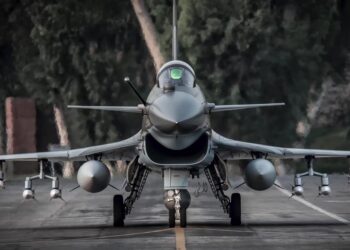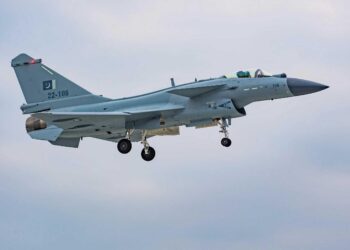FORT LEAVENWORTH, Kan: As the Army moves forward, differences between conventional and irregular warfare are becoming less important, Defense Secretary Robert M. Gates told students and faculty during a speech at the Army Command and General Staff College here today.
“To some extent, much of the debate between low-end and high-end [warfare] misses the point,” Gates said. “The black-and-white distinction between conventional war and irregular war is becoming less relevant in the real world.”
Roughly 80 percent of the officers Gates addressed served in combat in Iraq or Afghanistan, and they are uniquely qualified to lead the Army of the future, he said. The secretary was surrounded by reminders of Army heroes: He spoke at the Eisenhower Auditorium next to the MacArthur Room in the Lewis and Clark Building.
The U.S. military has overwhelming conventional military dominance over any potential adversary in the world, but experience has shown that isn’t enough, given the threats America faces, Gates said.
“Possessing the ability to annihilate other militaries is no guarantee we can achieve our strategic goals – a point driven home especially in Iraq,” he said. “The future will be even more complex, where conflict most likely will range across a broad spectrum of operations and lethality — where even near-peer competitors will use irregular or asymmetric tactics, and nonstate actors may have weapons of mass destruction or sophisticated missiles.”
The Army is working to institutionalize the lessons learned from counterinsurgency operations, Gates said, but the students and faculty at the staff college also must be at the forefront of thinking ahead to future conflicts that will traverse that broad spectrum of operations.
“You must develop the analysis, doctrine, strategy and tactics needed for success in 21st century conflicts that are likely to be very different from 20th century conflicts – and different from conflicts we are in now,” he said. “You must continue to be the visionaries, the pathfinders, the intellectual cutting edge of the Army.”
The Army must modernize equipment for future conflicts and identify technologies that will continue U.S. military dominance, the secretary said. “Advances in precision, sensor information and satellite technologies have led to extraordinary gains that will continue to give the U.S. military an edge over its adversaries,” he told the students and faculty. “But no one should ever neglect the psychological, cultural, political, and human dimensions of war or succumb to the techno-optimism that has muddled strategic thinking in the past.” This is especially true for the Army and Marine Corps, which will lead – and bear the brunt of – irregular and hybrid campaigns in the future, he said.
Gates quoted Army Gen. Joseph “Vinegar Joe” Stillwell, the U.S. commander in the China, Burma, India theater in World War II, who said, “No matter how a war starts, it ends in mud. … It has to be slugged out. There are no trick solutions or cheap shortcuts.”
The secretary praised the Army and the staff college for adapting to the current wars. “Leaders here have learned and explored the latest technologies,” he said, “and are currently using the Web, social media and other tools to rapidly turn battlefield lessons learned into usable tactics, techniques and procedures.”
The staff college and the Center for Army Lessons Learned worked to develop the counterinsurgency doctrine under then-Lt. Gen. David H. Petraeus. “It was used to great success during the surge in Iraq, and is helping guide our strategy in Afghanistan,” Gates said.
The Center for Army Lessons Learned is shouldering the herculean task of codifying and collating an enormous amount of information flowing in from the battlefield and around the world. This information then is distilled into products providing guidance on topics ranging from operations to counter roadside bombs to tribal customs. These products help to maintain U.S. combat leaders’ decision-making superiority over an adaptive and implacable enemy, the secretary said.
“Carrying that spirit of innovation forward, Army senior leaders have sought real-time feedback – online and off – on a range of issues including the spectrum of current operations, the Army’s force generation system and stress on the force,” Gates said.
The secretary stressed the responsibility the young officers have for the physical and mental health of the force.
“With regard to reducing the strain on soldiers and their families, we have made some headway but are not where we need to be,” he said. “At the height of the Iraq war, the Army was operating at roughly a 1-to-1 dwell time ratio [of time deployed to time at home station] for certain specialties, while others were deploying rarely, if at all. It was unsustainable.
“As you know, the Army has now set a goal of two years at home for one year deployed for the active duty, and four to one for the Guard and Reserve,” he continued. “Part of the solution is increasing the pool of soldiers available to deploy.”
Gates noted he authorized more soldiers and Marines, and he later authorized a temporary increase of more than 20,000 soldiers for the high-demand period.
“With this increase and our ongoing drawdown in Iraq, we have made strides towards the goal of 1-to-2, but we aren’t there yet,” he said. “In reality, the current strain will continue at least well into next year as the drawdown in Iraq is partially offset by the troop increase in Afghanistan, where a gradual transition to Afghan security responsibility will begin next summer.”
The increase in end-strength is only half of the picture, Gates said, as the Army is rebalancing billets and units within and between the active and reserve components.
“We are disbanding or reducing Cold War-era companies – for example, air defense in the National Guard – and standing up high-demand, low-density units like special operations, military police and others,” he said. “All told, the Army has undergone its largest organizational transformation since World War II, and has done so with 100,000-plus soldiers continuously deployed since the beginning of the Iraq war.”
Fighting the current wars is his highest priority, the secretary said, but close behind is the continuing care of those wounded and injured.
“This means ensuring they receive world-class medical, mental, and transitional support,” he said. “I remain concerned about soldiers’ outpatient care, which has again received some less-than-flattering reviews in recent weeks.”
Army leadership – especially Chief of Staff Gen. George W. Casey Jr. and Vice Chief of Staff Gen. Peter W. Chiarelli – are championing the Army’s efforts to care for those suffering from post-traumatic stress and traumatic brain injury, as well as comprehensive suicide-prevention efforts and doing everything possible to address and reduce the disturbing increase in suicide rates.
But efforts from senior leaders are not enough, Gates said.
“As military leaders, you must care for your subordinates and make sure they have the information, resources, and skills they need to be successful soldiers and members of society,” he said. “Strong unit-level leadership is needed not just to prevent soldiers from ending their lives, but to open the door for them to seek help.” He urged the young officers to make this a visible and vocal priority in their organizations.
“We all have our part to play to end the stigma of seeking help for mental-health issues,” he said. “If someone is struggling with what they have seen in combat or adjusting to a home environment, it is your duty to give them the support they need.”
Gates encouraged the students “to keep the entrepreneurial and sometimes contrarian spirit that you have developed during your combat tours.”
“You have had unique learning experiences – from providing security for elections that determine the fate of nations to getting feuding groups to work together instead of killing each other,” he said. “You have learned how to restore infrastructure and services to places that desperately need them, and how to understand the strategic impact those improvements can have.
“You have been in deadly firefights, and you have seen your soldiers wounded and die,” he continued. “Now, you must incorporate all these experiences and lessons into your training cycle to institutionalize what you have learned – capabilities that will be critical to success in Afghanistan and other potential conflicts.”









